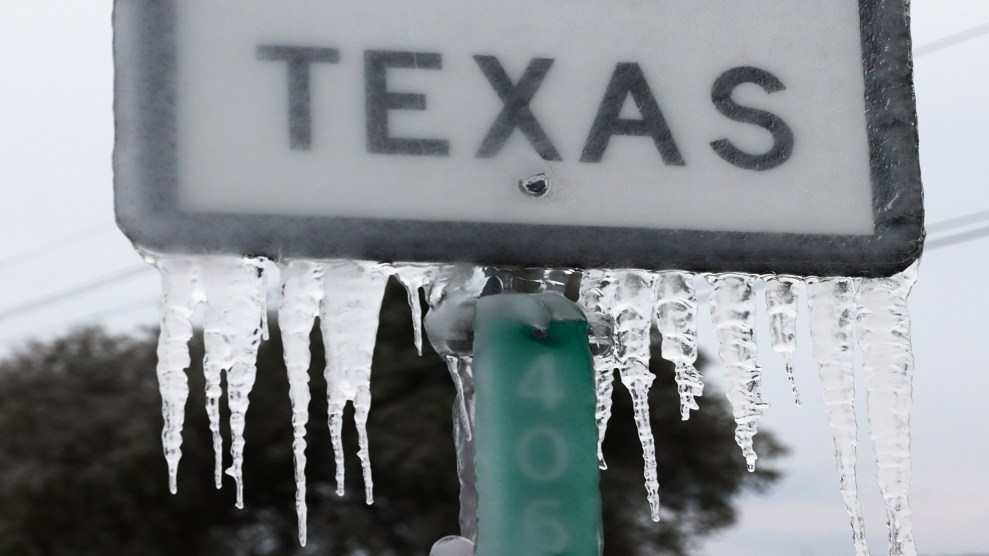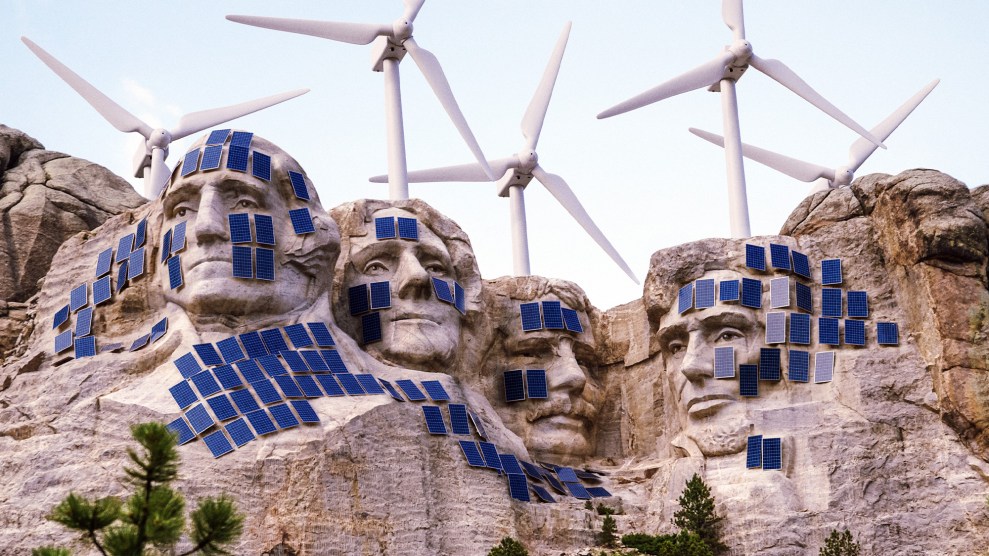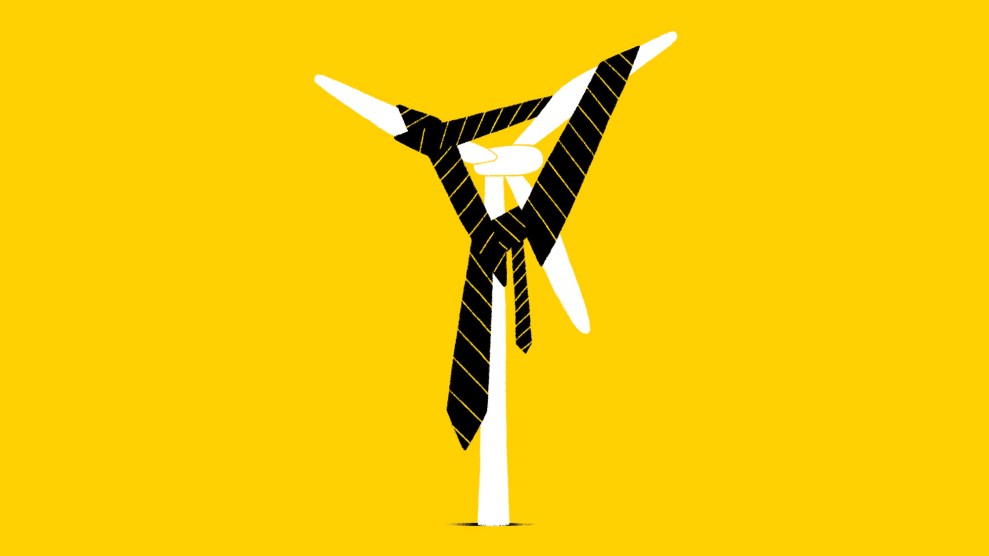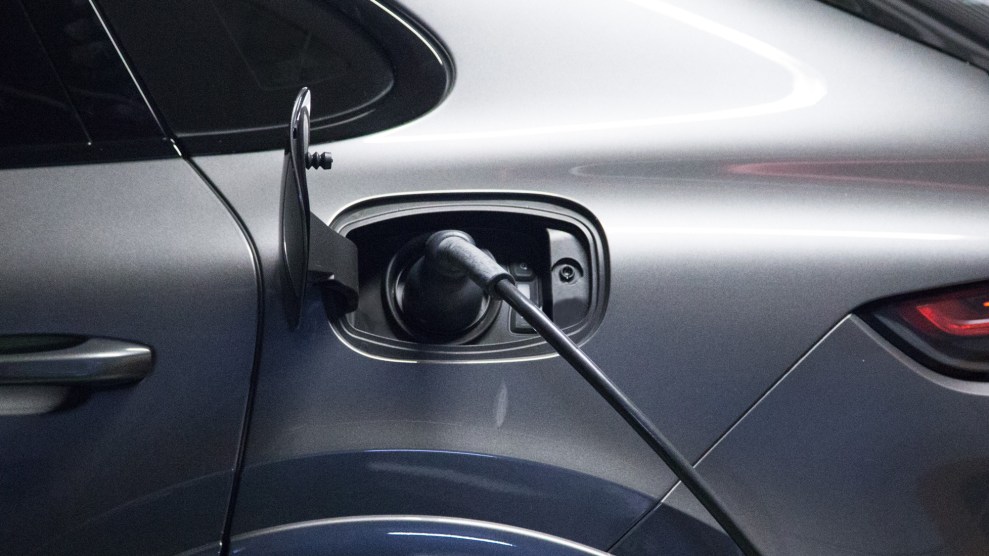
Icicles hang off the State Highway 195 sign on February 18, 2021 in Killeen, Texas. Joe Raedle/Getty
This story was originally published by Slate and is reproduced here as part of the Climate Desk collaboration.
Ever since brutal winter storms blacked out much of Texas and killed hundreds of residents in February 2021, the state’s government has constantly talked a big game about bolstering its grid and shielding Texans from future disasters. There is shockingly little to show for it. Lt. Gov. Dan Patrick announced that the Texas Senate, with “a strong bipartisan majority,” had passed a “power grid reform package” of bills purportedly intended to “make sure that Texans have reliable power under any circumstance.”
Featuring nine pieces of legislation and a joint resolution, the package appears impressive at a glance; there are new rules governing energy costs, power-transmission incentives, and protection against grid attacks. State senators from both parties are happy to declare that the new laws—now awaiting final amendment and approval in the Texas House of Representatives—will beef up the state’s electricity markets and ensure reliability for consumers, a talking point echoed in media coverage.
Yet a keener analysis of the Senate bills reveals that they hardly do anything to keep the grid running—and, in their current form, would actually make Texans’ power woes even worse. Should they pass, the result wouldn’t just be an ill-equipped Texas grid, but an even weaker electrical system than the one that failed two years ago.
One of the headline bills from the package is SB 6, which establishes the Texas Energy Insurance Program—namely, a plan to construct new natural gas plants that would generate and hold up to 10,000 gigawatts of backup power when needed. These multibillion-dollar facilities would be weatherized to hold against severe storms and sit idle more than 97 percent of the time, as the Houston Chronicle noted. In addition, SB 6 would set up an insurance fund to keep older natural gas plants online so they can also provide 24/7 backup should the grid collapse again.
The other major piece of legislation is SB 7, which provides incentives for private companies to set up energy plants that can “come on within two hours and run for at least four hours”—which means even more natural gas. The key word is dispatchable energy, referring to energy sources that can be turned on and put into effect at all hours of the day. That language is meant to exclude renewables, since sunlight and wind currents are not available 24/7 in almost any climate. Of course, several providers have solved this oft-cited “intermittency” issue through various means: storage of renewable-generated energy in batteries, interconnected home-and-public-power transmission, compressed air. That doesn’t seem to matter to SB 7’s authors, who explicitly position their bill as an alternative to “low non-dispatchable power production.”
You don’t have to peruse that much more to detect a pattern: These are bills meant to boost fossil fuels and crowd out renewables. SB 1287 requires energy companies to cover more of the costs of connecting to the grid depending on distance—in what amounts to an added tax on renewable generators that often operate farther away from the central source and depend on lengthy transmission lines. Then there’s SB 2012, which would “incentivize the construction of dispatchable generation” and “require electric companies to pay generators to produce power in times of shortage.” Definition: more gas buildout, and more levies on electricity providers instead of gas producers. SB 2014 “eliminates Renewable Energy Credits” so as to “level the playing field” with gas sources—never mind the generous tax breaks that already benefit fossil fuel producers. SB 2015 “creates a goal of 50% dispatchable energy” for the central grid, essentially mandating that gas sources provide at least half of Texas’ electricity at all times. Senate Joint Resolution 1 hopes to enshrine SB 6’s gas backup program in the state constitution as a new amendment.
There’s still more outside of this core package. The Legislature is also considering SB 624, which, according to the Texas Tribune, “would require the Texas Parks and Wildlife Department to review environmental impacts for wind and solar projects” and also make clean energy developers “hold public meetings” before any of their projects are approved. Doesn’t sound like a terrible idea, until you consider the fact that “other kinds of development don’t automatically have to host a community meeting or undergo the same level of environmental review before breaking ground”—and that all fossil fuel projects are far more environmentally ruinous than solar and wind appliances.
There’s another Senate proposal that could impose extra fines on Texans who complain to the government about environmental-law violations if those complaints don’t result in enforcement actions, an apparent effort to dissuade citizens from alerting authorities to pollution. Don’t count on the Texas House to improve any of these bills, by the way: The lower chamber has a bill that would provide tax breaks to certain new infrastructure projects, in a list that includes oil and gas and electricity production, but excludes renewable energy proposals.
On Tuesday, both legislative chambers passed a bill to forbid Texas cities from enacting any California-style future bans on sales of gas-powered cars. That comes right as the Statehouse considers imposing a new annual fee for electric cars registered in Texas, which will inevitably hurt clean-car sales—even though EVs can be used to share power with and help stabilize the grid.
These throughlines suggest that the “power grid reform” is less concerned with grid protection than with subsidizing Texas gas, whose crippling failures contributed in large part to the 2021 crisis—and which, through the magic of the state’s deregulated, regional energy marketplace, is beginning to be crowded out by renewables. Weatherized gas backup, as delineated by Senate bills 6 and 7, might appear to be a reasonable solution, if not for the fact that much of 2021’s crisis stemmed from the failures of lines transmitting natural gas. Gov. Greg Abbott’s infamous, and untrue, post-disaster claim that wind-energy failures caused the 2021 blackouts has now been translated into opportunistic policy, with potentially horrific outcomes for Texans.
To be clear, renewable power did suffer failures in 2021 as well—all aspects of statewide electricity supply were battered by the storms. Still, as the Texas Tribune has explained, gas was and still is Texas’ dominant power source, and “more than half of the state’s natural gas supply shut down” during the storm “due to power outages, frozen equipment and weather conditions.”
It’s not just that gas failed Texans back then, but that renewables have often saved them ever since. In recent years, properly constructed solar-and-battery installations across the US have proved to be reliable and resilient electricity providers in the midst of hurricanes, floods, and wildfires—even during last summer’s Texas heat waves, when solar and wind helped meet at least one-third of the surge in power demand that stemmed from air conditioning and other cooling methods, the Dallas Morning News has reported.
One of the most bizarre features of Texas’ new energy-legislation blitz, as various state residents have pointed out, is that it goes against every free-market instinct otherwise embraced by the current government’s hyperlibertarian regime. Texas is the nation’s largest wind-energy developer, and is on track to install more solar power this year than any other state (something Texas could rub in California’s face if it wanted). Gas still leads the Texan energy mix, but wind comes up second, per the state comptroller. Together, wind, solar, and, nuclear provided nearly as much Texan fuel in 2021 as natural gas, and generated twice as much energy as coal.
Environmentalists who remain nervous about the dangers of nuclear fallout can take heart in the fact that Texas is projected to push ahead with far more wind and solar energy than with thermal sources. The costs of installing and generating renewable resources have crashed over the past decade, which means their rapid expansion in the Lone Star State makes economic sense, not just climate sense. (There are also a bunch of cool federal government incentives now, thanks to the Inflation Reduction Act.)
However, it seems state lawmakers are either too blinded by their attachment to oil and gas to take heed of this fact. Or, more likely, they’re lashing out against renewables as part of the national GOP’s fossil fuel death grip. It wasn’t just clean-energy advocates and climate activists who opposed the “power grid reforms”—so did many of the state’s utilities, who were upset that the bills would impose an inefficient power structure and drive up operating expenses for electricity providers. Democratic state Sen. José Menéndez noted that none of the proposed bills addressed how to handle the energy—and money—lost and wasted due to lack of home insulation or power-plant weatherization.
There are further concerns that, due to the complex and insular nature of Texas’ lone-standing state grid, simply providing more energy that sits idle most of the time (as proposed in SB 6) would drive up costs for consumers, many of whom were also hurt by the skyrocketing energy bills that resulted from the 2021 supply failures. As Bloomberg’s Liam Denning characterized it, the energy package can best be summed up as “handouts to an industry growing ever more nervous about its competitiveness in an energy transition from which Texas, like many red states, has much to potentially gain.”
The primary fear among Texas Republicans seems to be that if green power overtakes fossil energy in the grid’s mix, the state would lose its defining reputation as an oil-and-gas treasure chest. However, their cynical approach to preserving this bit of Texas history is to couch their gas cheerleading as a grid solution. “We’re closing in on 50 percent of our generation portfolio in Texas being renewables,” Republican state Sen. Charles Schwertner, one of SB 6’s lead sponsors, told a local Fox network. “It certainly has cost advantages, but we have to focus on reliability and resiliency.”
This is, frankly, a nonsensical statement. If the Texas Senate were legitimately concerned about “reliability and resiliency,” its members would write bills meant to not only add more weatherized power, but also to protect current energy systems, add insulation to Texas homes and businesses, install more transmission lines, explore alternative power sources from other regional grids—and, yes, diversify the electricity mix so that if one primary source of power fails, others can carry the load. Gifts for gas and penalties for renewables will not protect Texans, but that’s where their elected officials have decided to go.
Texas has a whole host of climate and environmental problems coming in the near future, from flooding to disaster insurance coverage to blackouts to large-scale storms. Yet, in the time since the 2021 winter blackouts scarred countless Texans, the state government has opted to pursue minimal measures at best to protect the grid, and then lie to its constituents in declaring all problems to be solved.
In fairness, there have been some promising moves taken on behalf of Texas power—a bill limiting payouts to energy-sucking Bitcoin farms, a separate bill increasing fines on industrial facilities that pollute the environment, an El Paso city plan to set new green-energy goals. But for the most part, they’ve been outstripped by the Texas government’s loyalty to the very oil and gas systems that have wrecked much of the beloved state. When the Legislature winds down its current session next month, it will try to tell Texans that it’s taken substantive, valuable action to make sure a 2021-level disaster doesn’t happen again. Texans shouldn’t fall for it.
















